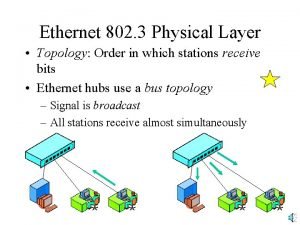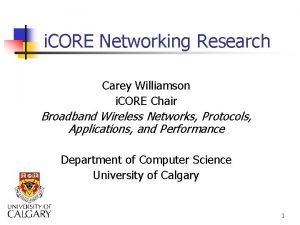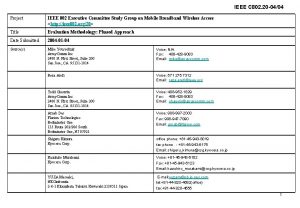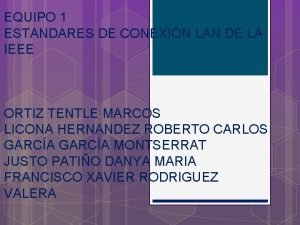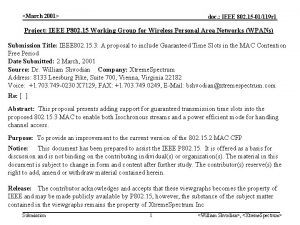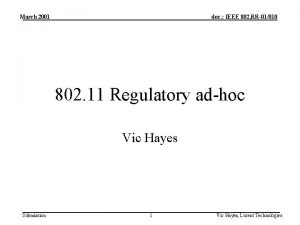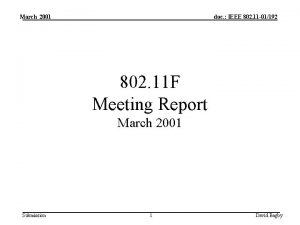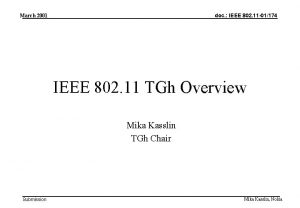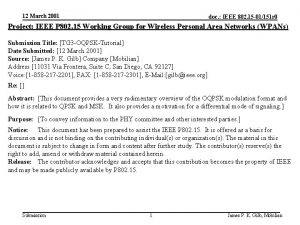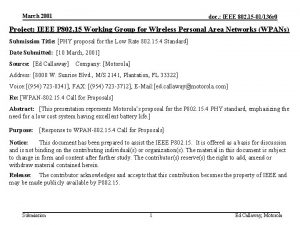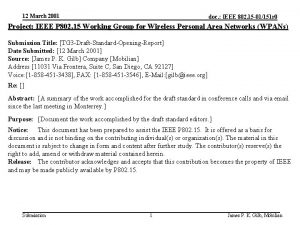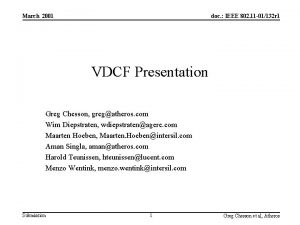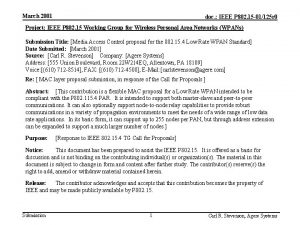March 2001 doc IEEE 802 15 01119 r

















- Slides: 17

<March 2001> doc. : IEEE 802. 15 -01/119 r 1 Project: IEEE P 802. 15 Working Group for Wireless Personal Area Networks (WPANs) Submission Title: IEEE 802. 15. 3: A proposal to include Guaranteed Time Slots in the MAC Contention Free Period Date Submitted: 2 March, 2001 Source: Dr. William Shvodian Company: Xtreme. Spectrum Address: 8133 Leesburg Pike, Suite 700, Vienna, Virginia 22182 Voice: +1. 703. 749 -0230 X 7129, FAX: +1. 703. 749. 0249, E-Mail: bshvodian@xtremespectrum. com Re: [ ] Abstract: This proposal presents adding support for guaranteed transmission time slots into the proposed 802. 15. 3 MAC to enable both Isochronous streams and a power efficient mode for handling channel access. Purpose: To provide an improvement to the current version of the 802. 15. 2 MAC CFP Notice: This document has been prepared to assist the IEEE P 802. 15. It is offered as a basis for discussion and is not binding on the contributing individual(s) or organization(s). The material in this document is subject to change in form and content after further study. The contributor(s) reserve(s) the right to add, amend or withdraw material contained herein. Release: The contributor acknowledges and accepts that these viewgraphs becomes the property of IEEE and may be made publicly available by P 802. 15, however, the substance of the subject matter contained in the viewgraphs remains the property of Xtreme. Spectrum Inc Submission 1 <William Shvodian>, <Xtreme. Spectrum>

<March 2001> doc. : IEEE 802. 15 -01/119 r 1 Overview • Discuss the need to address MAC power conservation and complexity issues • Present a modified Contention Free Period (CFP) for the 802. 15. 3 MAC Submission 2 <William Shvodian>, <Xtreme. Spectrum>

<March 2001> • doc. : IEEE 802. 15 -01/119 r 1 Slot Cycle TDMA Issues Power management: – All terminals must listen at all times in order to receive and to know when to transmit. – The coordinator must listen at all times and transmit all CTS messages (called CSO in 01061 r 0 P 802 -15_TG 3 -SC-TDMA. ppt) – RTS/CTS (DIT/CSO) is required even for isochronous slots • Complexity: – Coordinator: Must calculate SC-TDMA assignments for all asynchronous and isochronous streams to ensure Qo. S requirements are met – Stations: Must participate in distributed algorithm to determine when to transmit and receive. • • • CTS comes from the Coordinator. This does not serve the usual purpose of ensuring that the target heard the RTS. The coordinator may be within range of the transmitter, but the intended target may not be. Overlapping piconets: SC-TDMA does not inherently provide the capability to allocate periods of a superframe for silence. A silent interval could be useful to allow for coexistence with adjacent WPANs, each transmitting in the other’s silence interval. A minislot, which is the lack of an event, is used to convey information – virtual token pass. Submission 3 <William Shvodian>, <Xtreme. Spectrum>

<March 2001> doc. : IEEE 802. 15 -01/119 r 1 Power Management References • Stemm et al. showed that in a typical WLAN usage scenario by far the most power (about 90 percent) is drawn by listening to the radio channel 1 • Example 802. 11 b Wireless LAN power usage Typical Current Transmit Receive Sleep Intel 300 m. A 170 m. A 10 m. A Sony 280 m. A 15 m. A Lucent 330 m. A 230 m. A 9 m. A 1) M. Stemm et al. , “Measuring and Reducing Energy Consumption of Network Interfaces in Hand Held Devices. ” Proc. Mo. Mu. C-3, Princeton, NJ, Sept. 1996. Submission 4 <William Shvodian>, <Xtreme. Spectrum>

<March 2001> doc. : IEEE 802. 15 -01/119 r 1 Importance of Power Management for IEEE 802. 15. 3 • 802. 15. 3 PAR – 7. Purpose of Proposed Project: [To provide a standard for low complexity, low cost, low power consumption (comparable to the goals of 802. 15. 1)and, high data rate wireless connectivity among devices within or entering the Personal Operating Space (POS). The data rate will be high enough, 20 Mbps or more (see 13 a), to satisfy a set of consumer multimedia industry needs for WPAN communications. The project will also address the Quality of Service capabilities required to support multimedia data types. ] • IEEE P 802. 15 WPAN High Rate Study Group Functional Requirements, Standards Development Criteria – The 802. 11 Standard does not address the power consumption envelope of the WPAN class of devices listed in section 1 a. Submission 5 <William Shvodian>, <Xtreme. Spectrum>

<March 2001> doc. : IEEE 802. 15 -01/119 r 1 Modified CFP • Allow for time slots with guaranteed start time at the beginning of each superframe (after the CAP), then use the remaining bandwidth for Slot Cycle TDMA • This was agreed on at the 802. 15. 3 ad hoc MAC meeting in Boulder on Feb 8 -9, 2001. Submission 6 <William Shvodian>, <Xtreme. Spectrum>

<March 2001> doc. : IEEE 802. 15 -01/119 r 1 Beacon Modified CFP Contention Access 1 Period Contention Free Period 2 4 5 1 2 3 4 1 2 4 Guaranteed Time Slots Variable Time Slots Mini slots • Guaranteed Time Slots (GTS) are fixed assignment times • Real time traffic and power sensitive devices utilize GTS for power efficiency • Variable Time Slots (VTS) are bounded time periods rather than single packets • VTS bandwidth is shared among power insensitive users with asynchronous traffic utilizing SC-TDMA • First station in the VTS portion of the SC period may rotate through for fairness, specified in Beacon Submission 7 <William Shvodian>, <Xtreme. Spectrum>

<March 2001> doc. : IEEE 802. 15 -01/119 r 1 Use of GTS and VTS slots • Real time constant rate traffic will use Guaranteed Time Slots (GTS). “Isochronous” traffic with fixed assignment slots get guaranteed bandwidth with bounded latency and latency variation • Real Time variable bit rate traffic will use GTS when power savings is critical. Real time variable bit rate traffic may use SCTDMA if bandwidth efficiency is more important than power usage • Power sensitive devices with asynchronous traffic can be assigned Guaranteed Time Slots. • Asynchronous traffic from less power sensitive devices will use SC-TDMA Variable Time Slots (VTS). Submission 8 <William Shvodian>, <Xtreme. Spectrum>

<March 2001> doc. : IEEE 802. 15 -01/119 r 1 Beacon Modified CFP (cont. ) Contention Access 1 Period Contention Free Period 2 4 5 1 2 3 4 1 2 4 Guaranteed Time Slots Variable Time Slots Mini slots • Devices only have to be awake to transmit or receive during a fraction of the superframe. This provides efficient battery powered operation. Submission 9 <William Shvodian>, <Xtreme. Spectrum>

<March 2001> doc. : IEEE 802. 15 -01/119 r 1 Advantages of this Modified Approach • Guaranteed Time Slots are fixed time – Supports low power mode – Bounds packet delay variation • • • Guaranteed Time Slots slots do not require RTS/CTS Coordinator doesn’t need to know Variable Time Slot packet sizes or throughput a priori, yet all remaining bandwidth is used efficiently and fairly Only terminals with Variable Time Slot streams need to listen to the VTS slots. Coordinator only needs to do scheduling of Guaranteed Time Slots. However, VTS (SC-TDMA) slot durations can be allocated for each terminal individually or all terminals can use the same time duration like token ring Simplifies the assignment calculations and assignments as compared to SCTDMA with mixed isochronous and asynchronous slots Adjacent piconet coordination possible Submission 10 <William Shvodian>, <Xtreme. Spectrum>

<March 2001> doc. : IEEE 802. 15 -01/119 r 1 Adjacent piconet coordination Beacon Piconet 1 Contention Free Period Contention Access 1 2 Period 5 Unassigned GTS Slot 1 2 3 4 Contention Free Period Unassigned GTS Slot 1 2 4 Beacon Piconet 2 Contention Free Period Access 1 3 4 Unassigned 5 GTS Slot Period Superframe n+1 Superframe n • Un-assigned GTS slots can be used to allow multiple piconets to time division share a radio channel in a coordinated manner • This feature supports to goal of coexistence with 802. 11 b by allowing multiple 802. 15. 3 piconets the ability to time share a channel. Submission 11 <William Shvodian>, <Xtreme. Spectrum>

<March 2001> doc. : IEEE 802. 15 -01/119 r 1 Dynamic Reallocation of GTS Bandwidth • Show GTS can supply dynamic allocation of bandwidth for VBR and asynchronous traffic and signaling traffic – Random access requests – Fixed assignment requests – Piggybacked requests Submission 12 <William Shvodian>, <Xtreme. Spectrum>

<March 2001> doc. : IEEE 802. 15 -01/119 r 1 Beacon GTS with Fixed Assignment Reservations Contention Access 1 Period Contention Free Period 2 4 3 5 Guaranteed Time Slots Assigned Reservation Slots Unassigned Slot • Guaranteed Time Slots (GTS) are fixed assignment times • Each Terminal is assigned a fixed assignment reservation slot • Beacons contain the assignments • Higher overhead than piggyback requests, but better fairness • Coordinator only has to listen to a finite part of the superframe to make reservation requests Submission 13 <William Shvodian>, <Xtreme. Spectrum>

<March 2001> doc. : IEEE 802. 15 -01/119 r 1 Beacon GTS with Fixed Assignment Reservations Contention Access 1 Period Contention Free Period 2 4 3 5 Guaranteed Time Slots Random Access Reservations Unassigned Slot • Guaranteed Time Slots (GTS) are fixed assignment times • Terminals use Slotted Aloha or CSMA/CA for requests • Best for a network with a large number of users because fixed bandwidth is not needed for (not a WPAN) Submission 14 <William Shvodian>, <Xtreme. Spectrum>

<March 2001> doc. : IEEE 802. 15 -01/119 r 1 Beacon GTS with Piggyback Reservations Contention Access Period Contention Free Period 1 2 3 4 5 Guaranteed Time Slots Reservation in Header Unassigned Slot • Guaranteed Time Slots (GTS) are fixed assignment times • Each Terminal is assigned a fixed assignment reservation slot • Lower overhead than Fixed Assignment Reservation slots, but less fairness (reservations at the start of the superframe are disadvantaged) Submission 15 <William Shvodian>, <Xtreme. Spectrum>

<March 2001> doc. : IEEE 802. 15 -01/119 r 1 Summary of dynamic allocation of GTS bandwidth • GTS provides the ability to dynamically allocate all bandwidth and provided needed Qo. S for isochronous CBR and VBR streams, with remaining bandwidth assigned to asynchronous traffic • CBR streams can be assigned bandwidth for the duration of a call, without requiring requests every superframe • The current GTS baseline supports the use of fixed assignment reservations at the end of the superframe or piggybacked reservations during an assigned slot • Terminals request bandwidth assignment can change once per superframe • Overhead for reservations is offset by the lack of overhead for DIT/CSO Submission 16 <William Shvodian>, <Xtreme. Spectrum>

<March 2001> doc. : IEEE 802. 15 -01/119 r 1 Summary • Modify the Contention Free Period to allow Guaranteed Time Slots – Provide Guaranteed Time Slots for isochronous streams and power sensitive devices – Provide Variable Time Slots for those devices with variable rate streams and less stringent power concerns – Provides the potential for TDMA support for adjacent piconet coordination – This approach provides high performance, good Qo. S and high battery power efficiency • GTS alone can be used to provide dynamic bandwidth allocation Submission 17 <William Shvodian>, <Xtreme. Spectrum>












